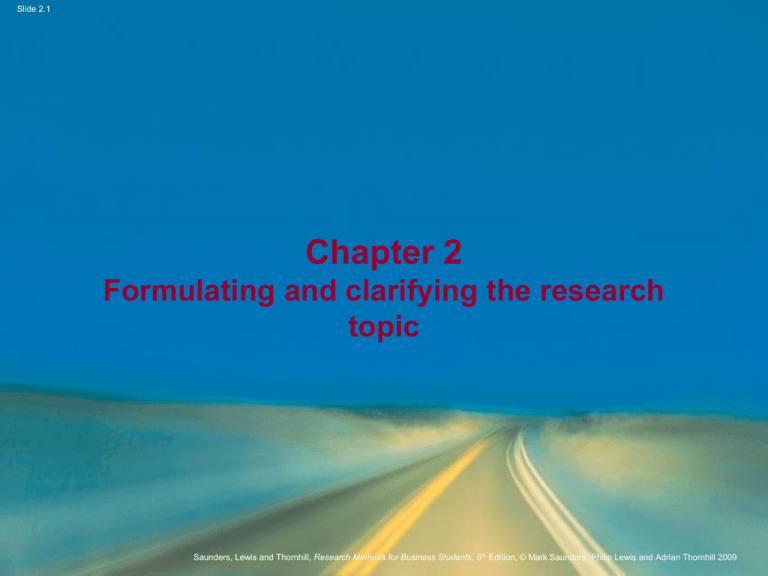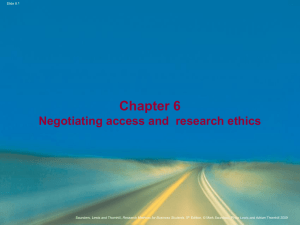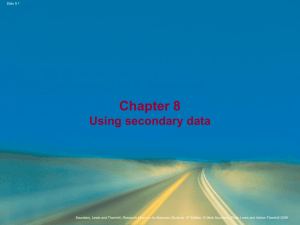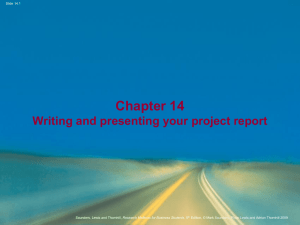Chapter 2 Formulating and clarifying the research topic
advertisement

Slide 2.1 Chapter 2 Formulating and clarifying the research topic Saunders, Lewis and Thornhill, Research Methods for Business Students, 5th Edition, © Mark Saunders, Philip Lewis and Adrian Thornhill 2009 Slide 2.2 Learning outcomes • By the end of this chapter you should be able to: • Generate ideas that will help in the choice of a suitable research topic; • Identify the attributes of a good research topic; • Turn research ideas into a research project that has clear research question (s) and objectives; • Draft a research proposal Saunders, Lewis and Thornhill, Research Methods for Business Students, 5th Edition, © Mark Saunders, Philip Lewis and Adrian Thornhill 2009 Slide 2.3 Formulating and clarifying your research topic The important steps • Identifying the attributes of a good research topic • Generating ideas that help you select a suitable topic • Turning ideas into clear research questions and objectives • Writing your research proposal Saunders, Lewis and Thornhill, Research Methods for Business Students, 5th Edition, © Mark Saunders, Philip Lewis and Adrian Thornhill 2009 Slide 2.4 Attributes of a good research topic (1) Capability: is it feasible? • Are you fascinated by the topic? • Do you have the necessary research skills? • Can you complete the project in the time available? • Will the research still be current when you finish? • Do you have sufficient financial and other resources? • Will you be able to gain access to data? Saunders, Lewis and Thornhill, Research Methods for Business Students, 5th Edition, © Mark Saunders, Philip Lewis and Adrian Thornhill 2009 Slide 2.5 Attributes of a good research topic (2) Appropriateness: is it worthwhile? • Will the examining institute's standards be met? • Does the the topic contain issues with clear links to theory? • Are the research questions and objectives clearly stated? • Will the proposed research provide fresh insights into the topic? • Are the findings likely to be symmetrical? • Does the research topic match your career goals? Saunders, Lewis and Thornhill, Research Methods for Business Students, 5th Edition, © Mark Saunders, Philip Lewis and Adrian Thornhill 2009 Slide 2.6 Attributes of a good research topic (3) And - (if relevant) Does the topic relate clearly to an idea you were given possibly by your organisation ? Saunders, Lewis and Thornhill, Research Methods for Business Students, 5th Edition, © Mark Saunders, Philip Lewis and Adrian Thornhill 2009 Slide 2.7 Generating research ideas Useful Techniques Rational thinking Creative thinking Searching the literature Scanning the media Brainstorming Relevance Trees Exploring past projects Discussion Keeping an ideas notebook Saunders, Lewis and Thornhill, Research Methods for Business Students, 5th Edition, © Mark Saunders, Philip Lewis and Adrian Thornhill 2009 Slide 2.8 Rational thinking • • • • • Examining your own strengths and interests Looking at past project titles Discussion Searching the literature Scanning the media Saunders, Lewis and Thornhill, Research Methods for Business Students, 5th Edition, © Mark Saunders, Philip Lewis and Adrian Thornhill 2009 Slide 2.9 Creative thinking • Keeping a notebook of ideas • Exploring personal preferences using past projects • Relevance trees • Brainstorming Saunders, Lewis and Thornhill, Research Methods for Business Students, 5th Edition, © Mark Saunders, Philip Lewis and Adrian Thornhill 2009 Slide 2.10 Rational thinking and creative thinking • These techniques will generate possible project one of two outcomes: • One or more possible project ideas that you might undertake; • Absolute panic because nothing in which you are interested or which seems suitable has come to mind. Saunders, Lewis and Thornhill, Research Methods for Business Students, 5th Edition, © Mark Saunders, Philip Lewis and Adrian Thornhill 2009 Slide 2.11 Examining own strengths and interests • Having some academic knowledge • Look at those assignments for which you have received good grade. • You may, as part of your reading, be able to focus more precisely on the sort of ideas about which you wish to conduct your research • There is a need to think about your future Saunders, Lewis and Thornhill, Research Methods for Business Students, 5th Edition, © Mark Saunders, Philip Lewis and Adrian Thornhill 2009 Slide 2.12 Looking at past project title • Dissertations; • Theses. Scan your university’s list of past project titles for anything that captures your imagination • Scanning actual research projects. You need to beware. The fact that a project is in your library is no guarantee of the quality of the arguments and observations it contains. Saunders, Lewis and Thornhill, Research Methods for Business Students, 5th Edition, © Mark Saunders, Philip Lewis and Adrian Thornhill 2009 Slide 2.13 Discussion • Colleagues, friends, university tutors, practitioner and professional groups Saunders, Lewis and Thornhill, Research Methods for Business Students, 5th Edition, © Mark Saunders, Philip Lewis and Adrian Thornhill 2009 Slide 2.14 Searching the literature • As part of your discussions, relevant literature may also be suggested. Sharp et al, (2002) discuss types of literature that are of particular use for generating research ideas. These include: • Article in academic and professional journals; • Reports; • Books. Saunders, Lewis and Thornhill, Research Methods for Business Students, 5th Edition, © Mark Saunders, Philip Lewis and Adrian Thornhill 2009 Slide 2.15 Scanning the media • Keeping up to date with items in the news can be a very rich source of ideas Saunders, Lewis and Thornhill, Research Methods for Business Students, 5th Edition, © Mark Saunders, Philip Lewis and Adrian Thornhill 2009 Slide 2.16 Keeping a notebook of ideas • One of the more creative techniques that we all use is to keep a notebook of ideas. All this involves is simply noting down any interesting research ideas as you think of them and, of equal importance, what sparked off your thought. You can then pursue the idea using more rational thinking technique later. Saunders, Lewis and Thornhill, Research Methods for Business Students, 5th Edition, © Mark Saunders, Philip Lewis and Adrian Thornhill 2009 Slide 2.17 Exploring personal preferences using past project 1. Select six projects that you like 2. For each of these six projects, note down your first thoughts in response to three questions(if responses for different projects are the same this does not matter); What appeals to you about the project? What is good about the project? Why is the project good? Saunders, Lewis and Thornhill, Research Methods for Business Students, 5th Edition, © Mark Saunders, Philip Lewis and Adrian Thornhill 2009 Slide 2.18 Exploring personal preferences using past project 3. Select three projects you do not like. 4. For each of these three projects that you do not like. What do you dislike about the project? What is bad about the project? Why is the project bad? Saunders, Lewis and Thornhill, Research Methods for Business Students, 5th Edition, © Mark Saunders, Philip Lewis and Adrian Thornhill 2009 Slide 2.19 Relevance tree • You start with a broad concept from which you generate further (usually more specific) topics. Each of these topics forms a separate branch from which you can generate further, more detailed sub branches. As you proceed down the sub branches more ideas are generated and recorded. These can then be examined and a number selected and combined to provide a research idea Saunders, Lewis and Thornhill, Research Methods for Business Students, 5th Edition, © Mark Saunders, Philip Lewis and Adrian Thornhill 2009 Slide 2.20 Brainstorming • Define your problem – that is, the sorts of ideas you are interested in – as precisely as possible. • Ask for suggestions, relating to the problem • Record all suggestions, observing the following rules: No suggestion should be criticized or evaluated in any way before all ideas have been considered; All suggestions, however wild, should be recorded and considered As many suggestions as possible should be recorded. • Review all the suggestions and explore what is meant by each. • Analyze the list of suggestions and decide which appeal to to you most as research ideas why. Saunders, Lewis and Thornhill, Research Methods for Business Students, 5th Edition, © Mark Saunders, Philip Lewis and Adrian Thornhill 2009 Slide 2.21 Refining research ideas • Using the Delphi Technique • Conducting a preliminary study • Continually testing out your ideas • Integrating ideas • Refining topics given to you by your organisation Saunders, Lewis and Thornhill, Research Methods for Business Students, 5th Edition, © Mark Saunders, Philip Lewis and Adrian Thornhill 2009 Slide 2.22 The Delphi technique • This involves using a group of people who are either involved or interested in the research idea to generate and choose a more specific research idea. To use this technique you need: 1. To brief the members of the group about the research idea; 2. At the end of the briefing to encourage group members to seek clarification and more information as appropriate; 3. To ask each member of the group including the originator of the research ideas based on the idea that has been described (justification) Saunders, Lewis and Thornhill, Research Methods for Business Students, 5th Edition, © Mark Saunders, Philip Lewis and Adrian Thornhill 2009 Slide 2.23 The Delphi technique 1. To collect the research ideas in unedited and nonattributable form and to distribute them to all members of the group; 2. A second cycle of the process (steps 2 to 4)in which comment on the research ideas and revise their own contributions in the light of what others have said; 3. Subsequence cycles of the process until a consensus is reached . These either follow a similar pattern (steps 2 to 4)in or use discussion. Voting or some other method. Saunders, Lewis and Thornhill, Research Methods for Business Students, 5th Edition, © Mark Saunders, Philip Lewis and Adrian Thornhill 2009 Slide 2.24 Writing research questions Write research questions that are • Consistent with expected standards • Able to produce clear conclusions • At the right level ( not too difficult ) • Not too descriptive • Use the ‘Goldilocks Test’ Clough and Nutbrown (2002) Saunders, Lewis and Thornhill, Research Methods for Business Students, 5th Edition, © Mark Saunders, Philip Lewis and Adrian Thornhill 2009 Slide 2.25 Goldilocks test • Clough and Nutbrown use what they call the Goldilocks test to decide if research questions are either too big two small too hot or just right/ • Too big need significant funding • Too small are likely to be insufficient substance • Too hot maybe so because sensitivities that may be aroused as a result of doing the research . This may be because of the timing of the research or the many other reasons that may be upset key people who have a role to play. • Just right are those just right for investigation at this time by this research in this setting Saunders, Lewis and Thornhill, Research Methods for Business Students, 5th Edition, © Mark Saunders, Philip Lewis and Adrian Thornhill 2009 Slide 2.26 Turning ideas into research projects (1) Examples of research ideas and their derived focus questions Table 2.2 Examples of research ideas and their derived focus research questions Saunders, Lewis and Thornhill, Research Methods for Business Students, 5th Edition, © Mark Saunders, Philip Lewis and Adrian Thornhill 2009 Slide 2.27 Turning ideas into research projects (2) Useful techniques • Start with a general focus question • Discuss areas of interest with your tutor Saunders, Lewis and Thornhill, Research Methods for Business Students, 5th Edition, © Mark Saunders, Philip Lewis and Adrian Thornhill 2009 Slide 2.28 Turning ideas into research projects (3) Writing clear research objectives • Check your examining body’s preferences for stated objectives • Use a general focus question to achieve precise objectives Saunders et al. (2009) Saunders, Lewis and Thornhill, Research Methods for Business Students, 5th Edition, © Mark Saunders, Philip Lewis and Adrian Thornhill 2009 Slide 2.29 Turning ideas into research projects (4) Include SMART Personal objectives Specific: What precisely do you hope to achieve from undertaking the research? Measurable: What measures will you use to determine whether you have achieved your objectives?(Secured a career-level first job in software design) Achievable: Are the targets you have set for yourself achievable given all the possible constraints? Realistic: Given all other demands upon your time, will you have the time and energy to complete the research on time? Timely: Will you have time to accomplish all your objectives? Saunders, Lewis and Thornhill, Research Methods for Business Students, 5th Edition, © Mark Saunders, Philip Lewis and Adrian Thornhill 2009 Slide 2.30 The importance of theory • Asking for opinions and gathering facts – 'what' questions (descriptive research) • Using questions that go beyond description and require analysis – 'why' questions Phillips and Pugh (2005) In order to: Explain phenomena Analyse relationships Predict outcomes Compare and generalise Saunders, Lewis and Thornhill, Research Methods for Business Students, 5th Edition, © Mark Saunders, Philip Lewis and Adrian Thornhill 2009 Slide 2.31 Theory • “ A formulation regarding the cause and effect relationship between two or more variables, which may or may not have been tested” Saunders, Lewis and Thornhill, Research Methods for Business Students, 5th Edition, © Mark Saunders, Philip Lewis and Adrian Thornhill 2009 Slide 2.32 Threefold typology of theories Grand, middle range and substantive theories Creswell (2002) Figure 2.1 Grand, middle-range and substantive theories Saunders, Lewis and Thornhill, Research Methods for Business Students, 5th Edition, © Mark Saunders, Philip Lewis and Adrian Thornhill 2009 Slide 2.33 Threefold typology of theories • Grand theories: Usually thought to be province of natural scientists . (that will lead to a whole new way of thinking about management) • Middle range theories: which lack the capacity to change the way in which we think about the world but are nonetheless of significance . (some of the theories of human motivation well known to manager would be in this category. • Substantive theories : that are restricted to a particular time, research setting, group or population or problem • Saunders, Lewis and Thornhill, Research Methods for Business Students, 5th Edition, © Mark Saunders, Philip Lewis and Adrian Thornhill 2009 Slide 2.34 Deductive approach and inductive approach • This discussion of theory dose assume that a clear theoretical position is developed prior to the collection of data (the deductive approach). • This will not always be the case. It may be that your study is based on the principle of developing theory after data have been collected (the inductive approach) Saunders, Lewis and Thornhill, Research Methods for Business Students, 5th Edition, © Mark Saunders, Philip Lewis and Adrian Thornhill 2009 Slide 2.35 Writing your research proposal Purposes of the research proposal • To organise your ideas • To convince your audience • To contract with your client (your tutor) • To meet ethical requirements Saunders, Lewis and Thornhill, Research Methods for Business Students, 5th Edition, © Mark Saunders, Philip Lewis and Adrian Thornhill 2009 Slide 2.36 Content of your research proposal (1) • Title - likely to change during the process • Background - context within the literature • Research questions and objectives - what you seek to achieve Saunders, Lewis and Thornhill, Research Methods for Business Students, 5th Edition, © Mark Saunders, Philip Lewis and Adrian Thornhill 2009 Slide 2.37 Content of your research proposal (2) • Method - can be in two parts: research design and data collection • Timescale and Resources - (finance, data access, equipment) • References - include some key literature sources Saunders, Lewis and Thornhill, Research Methods for Business Students, 5th Edition, © Mark Saunders, Philip Lewis and Adrian Thornhill 2009 Slide 2.38 Evaluating research proposals • How the components of the proposal fit together • Viability of the proposal • Absence of preconceived ideas Saunders, Lewis and Thornhill, Research Methods for Business Students, 5th Edition, © Mark Saunders, Philip Lewis and Adrian Thornhill 2009 Slide 2.39 Summary: Chapter 2 The best research topics • Formulate and clarify the topic • Meet the requirements of the examining body • Use a variety of techniques when generating research ideas • Are focused on clear questions based on relevant literature Saunders, Lewis and Thornhill, Research Methods for Business Students, 5th Edition, © Mark Saunders, Philip Lewis and Adrian Thornhill 2009 Slide 2.40 Summary: Chapter 2 The best research topics • Are theory dependent • Have a proposal containing organised ideas Tell the reader: • What will be done and why • How it will be achieved Saunders, Lewis and Thornhill, Research Methods for Business Students, 5th Edition, © Mark Saunders, Philip Lewis and Adrian Thornhill 2009



